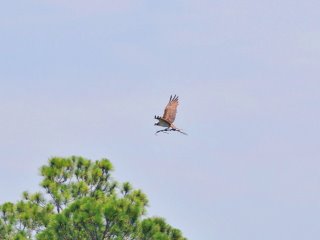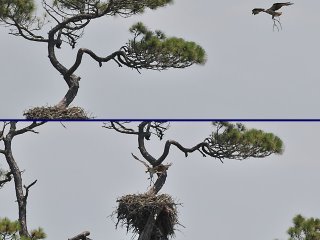Back home in northeast Georgia, we’re in the middle of a heat wave as summer officially arrives, with temperatures near 100 for the past few days, and more of the same in the forecast for next week. The rasp of cicadas rises and falls, and grasshoppers sing. Wasps, bees, dragonflies and other flying insects buzz and hum. Chimney Swifts chatter as they sweep low over the grass in the morning. Ruby-throated Hummingbirds visit the feeder and flowers on the back deck often. Red-eyed Vireos sing fast and constantly all day, but stay deep in the woods. Now and then I hear the sharp wheet of an Acadian Flycatcher from down near the creek.
The highlights of a morning walk for me – trying to beat the worst of the heat – were the summery call of a Yellow-billed Cuckoo, a pair of Red-tailed Hawks and a juvenile, and a Scarlet Tanager perched in a treetop and singing.
About 7:30 this morning it was already very warm and humid when I left the house. The sky was covered in high, rumpled clouds that drifted apart and faded away as I walked, clearing the way for another blistering sunny day. Around our yard the songs of a Northern Parula and a Pine Warbler sounded shady and cool. A Great-crested Flycatcher called whreep. Downy Woodpeckers and Red-bellied Woodpeckers rattled. Two Phoebes hunted from low branches.
Seven Crows stalked in the grass of a neighbor’s lawn across the street. Several Robins were scattered across the grass of another yard, and a couple of Robins sang from treetops. Blue-gray Gnatcatchers called spee from a thicket. Bluebirds flashed their colors all along the way, very active, and some perched in treetops and sang. Bird songs and calls generally were scattered and muffled and mostly in the distance, with a few exceptions – the dry cawp-cawp-cawp-cawp of a Yellow-billed Cuckoo, the lisping song of a Phoebe, the warbling of House Finches – and the enthusiastic songs of several Mockingbirds. One that sings from an area near the small pond does a near-perfect imitation of a Kingfisher’s rattle, as well as the scream of a Red-tailed Hawk, and variations on Carolina Wren, Brown-headed Nuthatch, White-eyed Vireo, Blue Jay, Cardinal and several more.
Goldfinches passed over, trailing their potato-chip calls, House Wrens sang cheery, energetic bursts of song here and there. Carolina Wrens, Chickadees, Titmice, Blue Jays, Cardinals and too many Brown-headed Cowbirds sang or called.
When I got to the old field, a Red-tailed Hawk was sitting on top of a pole overlooking the highway. Several mornings during the past week, two Red-tailed Hawks and one juvenile have been around this area – the juvenile often screaming while the adults perch quietly. This time, while I was watching, a second Red-tailed Hawk flew up and joined the first one on top of the same pole. Both of these were adults. They lifted their wings, looking as if they had a little trouble finding footing, but then they both settled down and sat there sharing the space, facing in opposite directions. I walked on, and when I saw them again on my way back, one had flown to the next pole out over the highway. A third Red-tailed Hawk – the juvenile – then circled high over the same area, crying repeatedly.
Earlier in the week a single Indigo Bunting sang almost every day in or near the field – sweet-sweet, chew-chew, sweet-sweet – but this morning it wasn’t there.
As I got close to home again, I heard the squeaking calls of Brown-headed Nuthatches, the long dry trill of a Chipping Sparrow, and saw several Bluebirds perched in trees and flying from place to place. But the best part of the walk came just as I reached our driveway, when I heard a few hoarse bars of a song and saw a tiny shape in the leaves at the top of a water oak across the street. It was a glass-red Scarlet Tanager, singing, in the same territory where one sang all day every day last summer.

